- Details
- Written by: Gianna Esquivel
- Hits: 1034
How do you like the title? Dramatic, right? While visiting Greece, you have zero chances to escape from the plenty of narrations related to Greek mythology. Greeks love those stories and take every opportunity to tell you about Zeus, Aphrodite, Hermes, Heracles (Hercules), Medusa, and many more. We enjoy them very much because of the passion people put into the telling. It is like they are talking about real heroes. Besides, the stories of these characters have a perfect dose of conflict, drama, passion, romance, treason, and death. You can listen for hours and stay on the edge of your seat, like when you watch your favorite thriller or drama.

The stories about Orpheus have accompanied us since the beginning of this trip. Finally, while visiting Pangaion Mountain, we heard the complete Orpheus myth told fascinatingly by a very nice Greek man.
We have no idea what Orpheus' voice or music sounded like, but we could almost hear both as we followed the story. It was a fun experience because as the story progressed, M and I musicalized Orpheus' love tragedy in our heads with contemporary musical references. Stay there and read until the end to know who the hell was Orpheus? What did happen in Pangaion Mountain? Was it true or just a myth? Then you can decide if to visit it or not.
What was Orpheus famous for?
Orpheus was not the feared leader of large armies or a skilled fighter like Jason or Heracles (Hercules) were. But he only needed music and his songs to succeed. Yes! Orpheus was a music composer, singer, and lyre player. It is said that his music was as beautiful and captivating, that no creature on Earth was not enchanted by it. He had a big gift and through it, he becharmed humans, rocks, trees, wild beasts, sirens, and even the gods! Orpheus was also famous for being the protagonist of a tragic love story with Eurydice.
He lived in Thrace, in the Northeastern part of Greece, exactly where we are traveling right now! But, when it comes to where Orpheus was born, lived, and died, answers can differ based on who responds to you. It is not rare that every country or town offers you a different version. Contradictions are very common and Orpheus's story is not an exception so take it easy.
Who was Orpheus?

The version we got says, Orpheus was the son of the muse Calliope and Oeagrus, a Thracian king. He is supposed to be born in Pimpleia, Piera, close to the Mount Olympus foothills. In Greek mythology, Calliope is considered the muse of dance, music, song, epic poetry, and the eloquence gift of kings. Such talents also attracted the eyes and heart of a god, Apollo, with whom she had two sons, Lalemus and Hymenaeus. And here the story gets messy. Some will say, that Apollo, god of poetry, music, sun, and light, saw Orpheus's gift, therefore he gave the kid his first lyre. But others will state that Apollo was Orpheus's father.
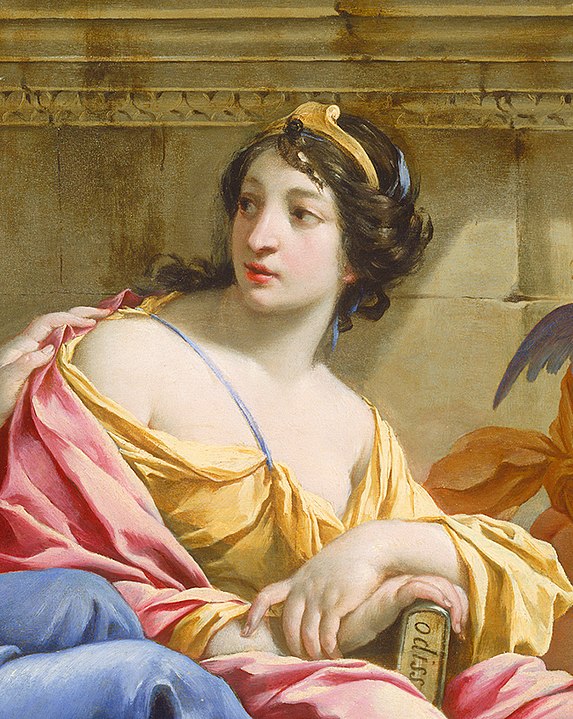
Public Domain.
In any case, this shows that Orpheus's gift was not a random event, having such a mother and with Apollo by his side or being his father, his talent was inherited. Due to his origin, some attributed him also the power of eloquently speech and prophesizing.
Was Orpheus a mortal or a god?
Many authors claim he was a mortal. But let’s see if his parents were Calliope and Apollo, Orpheus was definitely not a mortal. Apollo was a god and Calliope a muse, and muses were considered sort of goddesses too. If his parents were Calliope and Thracian King Oeagrus, Orpheus was a demigod, son of a goddess and a human. This makes sense because demigods could not escape death… and love just like we humans!

What are the most famous tales about Orpheus?
Orpheus took part in different adventures in which the music, his gift, was life-saving. Consider that the enchanting power of his voice and lyre stopped even the wildest rivers. They stopped their savage currents from flowing just to listen and enjoy Orpheus's music. It was such a useful gift, wasn’t it? Some of the most famous tales (myths) about Orpheus are:
Jason and the Argonauts
This myth revolves around Jason, a Greek hero, and his quest to retrieve the Golden Fleece, a symbol of authority, honor, and kingship. Jason was the rightful heir to the throne of Iolcus, however, his uncle Pelias usurped the throne and exiled him. To reclaim his rightful place, Jason embarked on a perilous journey to Colchis (currently Georgia), where the Golden Fleece was guarded by a fierce dragon and hung from a sacred tree. It was a dangerous quest so Jason recruited a group of heroes: the Argonauts.
Orpheus was one of the Argonauts and his musical talents were essential during this expedition. He used his music to soothe savage beasts and fears, comfort his companions, tame storms, treacherous waters, and the dragon itself.
| Follow PackAndGo.info at: | |
| YouTube | @packandgo. |
| @packandgo.info | |
| X | @packandgoinfo |
| Bluesky | @packandgo.bsky.social |
| @packandgo.info | |
| TikTok | @packandgo.info |
Orpheus vs the Sirens
During the Argonautic expedition, Orpheus encountered some of the most fearsome creatures from Greek mythology, the sirens among them.
Sirens were creatures that would enchant their victims with an irresistible melody. They lured sailors passing by their rocky island with their mesmerizing songs, leading them to their doom by causing shipwrecks on the rocky shores. During the voyage of the Argonauts, they sailed near the dangerous sirens' island. To protect his fellow Argonauts from the perilous temptation of the sirens' songs, Orpheus did what he did best! He began to play his lyre and sang with such enchanting and harmonious melodies that his music drowned out the alluring voices of the sirens.
Orpheus and Eurydice myth
This is the tragic love story we mentioned at the beginning and we will tell you about it right now!
What is the myth of Orpheus and Eurydice about?
The myth of Orpheus and Eurydice is a tragic love story you can’t miss. Orpheus and Eurydice was a match that seemed made in heaven. After his Argonaut adventure, Orpheus met Eurydice, a shy and beautiful nymph, in a gathering. It was love at first sight... and listen! Once he saw her, there was no way back. She got enchanted and deeply in love right after listening to his voice and music. It was like a magical and beautiful spell she could not resist. It was physical attraction and also the effect of Orpheus's gift.
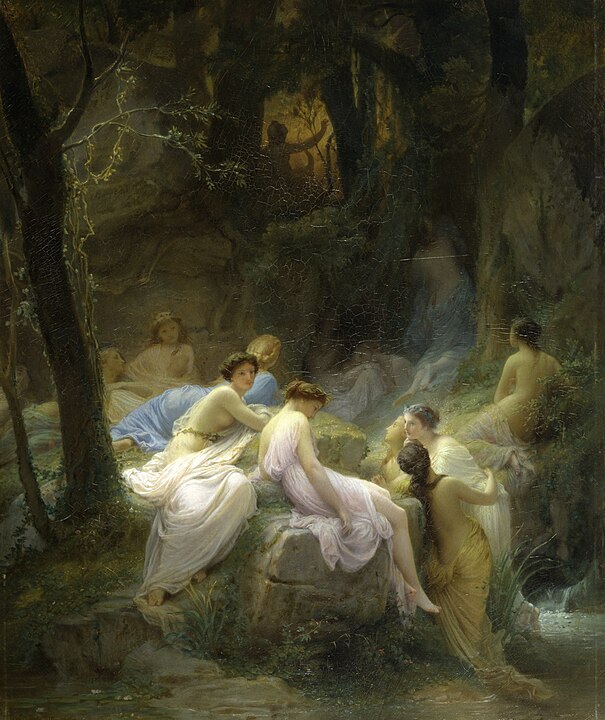
They became inseparable, a couple of lovebirds who could not hide their feelings for each other. Such a moment of Orpheus and Eurydice could have one of the following songs in the background:
- “Love is in the air” by John Paul Young (1977)
- "Can't Take My Eyes Off You" by Frankie Valli (1967)
- “Ho Hey” by The Lumineers (2012)
- “Fade into You” by Macy Star (1993)
- “Unchained Melody” by The Righteous Brothers (1955)
- "All of Me" by John Legend (2013)
- “Truly Madly Deeply” by Savage Garden (1997)
- "I Don't Want to Miss a Thing" by Aerosmith (1998)
- "Can't Help Falling in Love" by Elvis Presley (1962)
- "A Thousand Years" by Christina Perri (2011)
- "Love Story" by Taylor Swift (2008)
- "Crazy for You" by Madonna (1985)
- “I’m A Believer” by The Monkees (1966)
- "Perfect" by Ed Sheeran (2017)
- "Just the Way You Are" by Bruno Mars (2010)
- "Love on the Brain" by Rihanna (2016)
Can you feel the love and passion of this romance? Hopefully yes, otherwise you are not a human haha.
Soon, Orpheus and Eurydice decided to get married. Hymenaios, the god of marriage, informed the bride and groom that their happiness would last short. But the couple was madly in love and dismissed the warning.
The wedding day arrived, Hymenaios blessed their union and a great feast started. It was a great celebration, except for Aristaeus, a shepherd who despised Orpheus because he desired Eurydice for him. He plotted a plan and when the shadows grew large and everybody went home, Aristaeus hid in the bushes to kill Orpheus. When the newlyweds passed close by, Aristaeus tried to kill Orpheus but he failed. The couple desperately ran into the forest to escape from Aristaeus who closely chased them. Suddenly, Orpheus felt Eurydice’s hand slip from his grasp and then she fell.

The beautiful bride was bitten by a venomous viper and in a few minutes, a deathly pallor suffused her cheeks. It was the tragic end of a great love. Orpheus got into a deep depression and grief. He played the most sorrowful songs ever. No creature was not moved by the pain of his music. To give you an idea, these could be Orpheus’ playlist at that time:
- “Ain’t no sunshine” by Bill Withers (1971)
- “Goodbye My Lover” by James Blunt (2005)
- “My Heart Will Go On” by Celine Dion (1997)
- “Someone Like You” by Adele (2011)
- “Wish You Were Here” by Pink Floyd (1975)
- “Here Without You” by 3 Doors Down (2002)
- “I Will Always Love You” by Whitney Houston (1992)
Then, he had a great but dark idea: to go to the Underworld and try to get his wife back. He asked Apollo to talk to Hades, the god of the Underworld, to let him in and hear his plea. To descend to the realm of the dead was another perilous journey for Orpheus. Using his lyre and voice, he played his mesmerizing music and mournful songs to persuade Cerberus, the three-headed dog, and the ferryman Charon, the guardians of the Underworld, to let him pass.
He managed to reach the depths of the Underworld, and there, he faced Hades and Persephone, the rulers of the dead. The beauty and emotional power of Orpheus's musical lamentations touched Hades, Persephone, and every stone in the Underworld. Both rulers agreed to grant Orpheus his wish under one condition: he could lead Eurydice back to the world of the living, but he must not look back at her until they reach the surface. If he looked back, Eurydice would return to the Underworld forever.
The deal was accepted and love was about to achieve the feat, but while ascending from the Underworld, Orpheus suddenly could not hear Eurydice’s footsteps behind him. Did he lose her? Did Hades break the deal? Unable to resist the urge to ensure she was truly following him, he glanced back before they reached the surface. That was tragic!
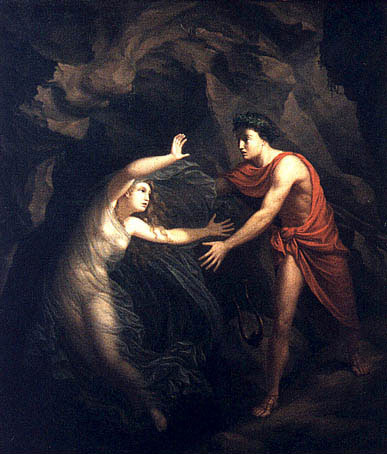
Public Domain.
Eurydice was instantly taken back to the realm of the dead and this time, forever. They were so close to making it! But he blew up the precious chance.
Orpheus was devastated and he spiraled into a deep, lifelong depression. His music and songs were dismal and he never looked for another wife.
How did Orpheus die?
After the tragedy, life sucked for Orpheus. He got back to Thrace, specifically to the Pangaion Mountain, where he literally cried out his soul! His music was the way to take out his grief. As a part of his routine, he daily climbed the Pangaion peaks to be the first to see the light of every day.
Orpheus started neglecting to worship Greek gods and goddesses. This made particularly angry the god of wine and pleasures, Dionysus. Besides, Dionysus's female followers, the Maenads, hated Orpheus because he refused them. He was not interested in women at all since the loss of Eurydice. Tired of Orpheus's grief and rejection, they decided to kill him.
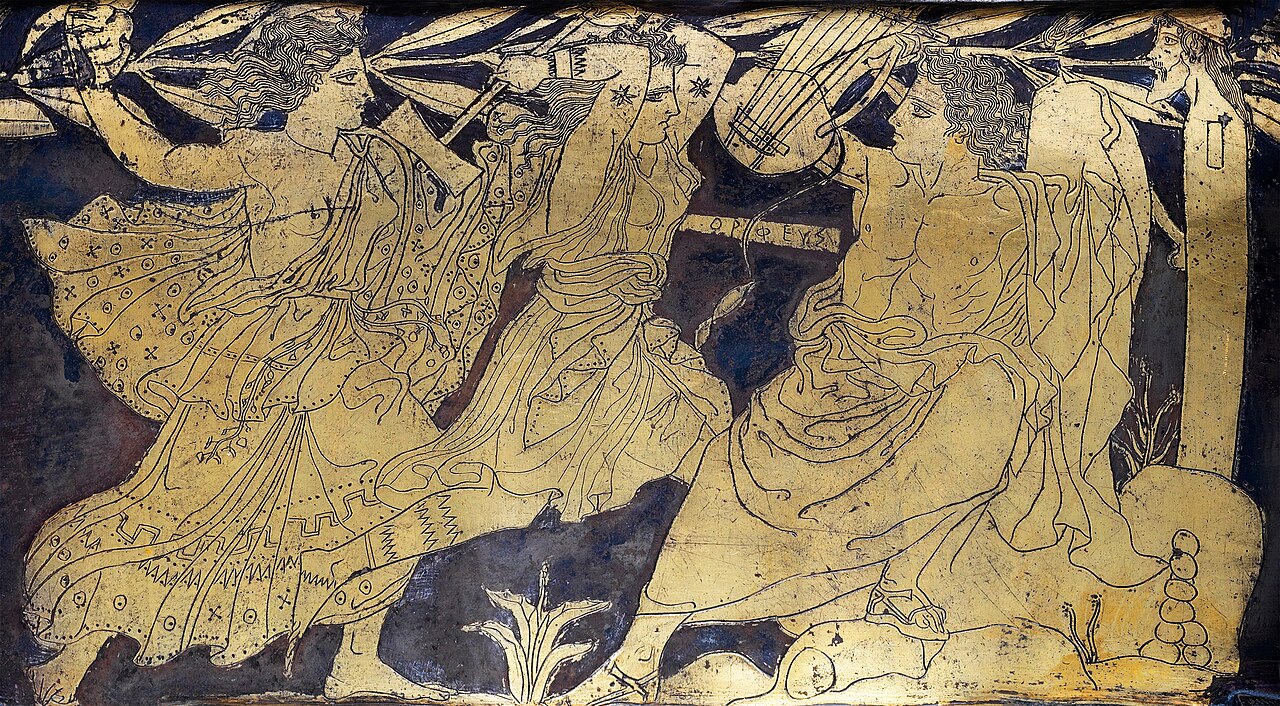
One day, while trekking in the woods of Pangaion Mountain, he encountered the Maenads. They attacked and tried to kill him by throwing rocks. But his lovely music caused the rocks to evade him, not to harm him. The Maenads got very mad. Killing Orpheus was not easy. They managed to attack him only when they started screaming and beating their drums until they drowned out Orpheus’ voice and music. Then, the Maenads finally killed him by tearing his body apart, limb by limb, with their own hands.
Where was Orpheus buried?
Early versions point out Pangaion Mountain as the place where Orpheus's remnants were buried. A further version tells Orpheus lyre and head reached the Hebros River, floated down until they encountered the sea, to finally arrive at the Lesbos Island pushed by the tides. The dismembered head of Orpheus -still singing- kept the power of speech, singing, and prophesizing. Aware of this, locals buried it and built a column of stone. With the power of the head, they started to prophesy. The rest of Orpheus’ remains were gathered from the Pangaion Mountain by the 9 Muses and buried in Leibethra, an ancient city at the base of Mount Olympus.

In 2002, a group of Greek archeologists claimed they found in Lesbos, the site where Orpheus remnants could be. But years later, Bulgarian archeologists announced that the place where Orpheus’ head was used to foretell was in Tatul, an archeological spot located in the core of the Rhodope mountain chain, close to the Kardzhali region.
To visit or not Pangaion Mountain?
Now, you know what happened in Pangaion Mountain. The place is also referred to as Pangaion Hills because its height is not very high. Its highest peak (Koutra) is 1,956 m. It is located in Northeastern Greece, 40 km away from Kavala City. It is close to other beautiful towns and beaches such as Palio, Nea Iraklitsa, Nea Peramos, and Ammolofoi Beach. Pangaion is a place rich in history, culture, and natural beauty. In the past, its ancient mines were a source of gold.

If you visit Pangaion Mountain, you can trek or hike the mountain trails, and enjoy the stunning scenery, have a look from the top to the Aegean Sea, while discovering remnants of caves and ancient settlements. The environment is calm and relaxing, ideal for outdoor adventures and to connect with Greek mythology. So, if your heart is broken, you can visit Pangaion Mountain and cry out your soul!
You can plan a longer stay on this nice mountain. We stayed a week in Pangeo Forest Village -10.93 km from Pangaion Hills- and we enjoyed it a lot. If you are into forests, nature, and mountains, look for Eleftherios, he runs the place and you can have the best time there following his recommendations and chatting about Greek history. The view from the restaurant is great, just like the Greek coffee (hot and cold) and the fasolada cooked by Eleftherios' wife!
You can book a room contacting Eleftherios (FB)!

A warning for you! When you visit Greece, behave! Collect your garbage, explore but without damaging the landscape, and leave everything as clean and untouched as you found it. Greece is a land of ruthless gods! They are permanently watching you and each of your moves. Remember you are only a mortal without any special gift, so don’t mess with them!

Conclusion
Greece is a great destination no matter the type of traveler you are. If you are into its deep history, archeological treasures, natural beauty, beaches, music, or mythology, it never disappoints! Follow our adventure in this land of gods, pleasures, and nice mortals. We still have a long way ahead.
You may want to read these articles too:
Kardzali is a hotspot for Turkish and Greek tourists, but not Bulgarian. Why?!
Why do youg people dislike Kavala?
It is official, Fanari has been occupied by Bulgaria!
Keramoti: The Beach Town You’re Not Visiting—And It’s Better Than Santorini!
| Follow PackAndGo.info at: | |
| YouTube | @packandgo. |
| @packandgo.info | |
| X | @packandgoinfo |
| Bluesky | @packandgo.bsky.social |
| @packandgo.info | |
| TikTok | @packandgo.info |
- Details
- Written by: Gianna Esquivel
- Hits: 1229
Guys, we have talked already about these beautiful Mexican fantasies called alebrijes. After publishing the article Alebrijes, meet these fantastic and colorful Mexican creatures! we receive many questions about them. So here you have the answers. We hope this can satisfy your curiosity and more importantly, that this gives you the last kick to Pack and Go to Mexico to meet these beautiful and exotic creatures in their homeland!

| Follow PackAndGo.info at: | |
| YouTube | @packandgo. |
| @packandgo.info | |
| @packandgoinfo | |
| @packandgo.info | |
| TikTok | @packandgo.info |
Are alebrijes from Mexico?
Yes, alebrijes are from Mexico. They were created by the Mexican handicraftsman, Pedro Linares López, who was born in Mexico City in 1906 and died in 1992 when he was 86 years old.
If you want to know more about the story behind the Mexican alebrijes, check Alebrijes, meet these fantastic and colorful Mexican creatures!
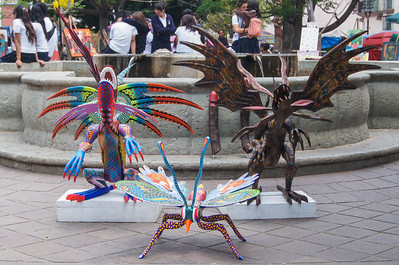
How many types of Mexican alebrijes are there?
There are two types of Mexican alebrijes, the ones made of paper, through the technique known as papier-mâché sculpting used by his creator, Pedro Linares López in 1936.
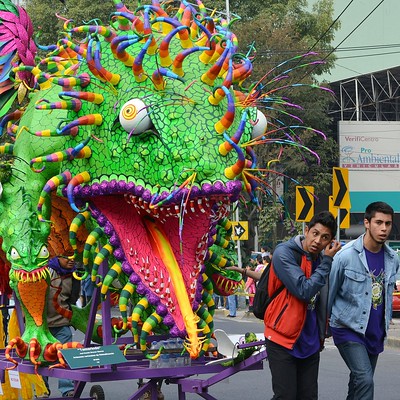
And the alebrijes sculpted in wood, like the Oaxaca ones made of copal wood instead of paper. Based on the Mexican region you are in, you can find more versions that use different types of wood.
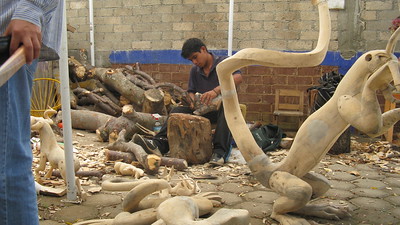
What powers do alebrijes have?
Alebrijes don’t have supernatural powers. Let’s explain this, taking away the nahual myth. An alebrije combines different features from different animals in a single creature. Therefore, the powers alebrijes could represent, not really have, are useful animal abilities and instincts. If you give wings to a jaguar, besides being a great swimmer and climber, it will fly. If you add to it an elephant trunk, the jaguar will gain a powerful sense of smell to track whatever. Remember that alebrijes were created far from myths. It was a handicraftsman's creation and contribution to Mexican popular art.
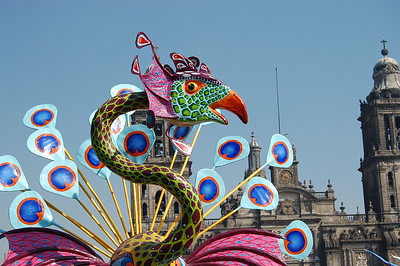
Now, if you look for an answer considering the nahual myth that has been connected with the alebrijes, the powers of nahuales -not of alebrijes- are said to be animal features. But the main difference here is that being connected with a human, those animals could take human shape and the human could transform on the animal. Just consider that the nahuales myth was taken as inspiration to create alebrijes in Oaxaca. But they are not the same thing. Most of the descriptions of nahuales describe them as beasts or normal animals.

Are alebrijes connected with the Day of the Dead?
No, alebrijes are not connected with the Day of the Death. Alebrijes were created by the Mexican Pedro Linares López in 1936. They were the result of his creator’s imagination.
But thinking about the version of alebrijes made in Oaxaca, their link with the nahual myth makes a connection with the Day of the Death.

In Oaxaca, it is believed that, whether in its guardian or evil version, a nahual can appear throughout the year. But during the Day of the Dead, the nahuales are more present because, on that day, the barrier that separates this world and that of the Dead (supernatural world) is erased for a few hours.
On the Day of the Dead, the nahuales coexist with the souls of those they protected in life and it is said, they are even visible to the living. Especially during the days around the Day of the Dead, people in Oaxaca are more careful and kind to animals. They think that these animals could be the nahuales of living or dead people.

What are alebrijes in Coco?
If you haven’t been yet to Mexico, pretty sure you already knew the alebrijes while watching the animated fantasy “Coco” (2017), of Disney.
Alebrijes were used by the creators of “Coco” like spirit guides of the main characters. Don’t forget it is fiction, therefore you shouldn’t take their version like it’s 100% historically accurate. But they used them in the film to include another native and visually attractive Mexican element. Alebrijes are exotic and very colorful and this turned out convenient to create the vibrant environment this Disney’s fantasy offers you.
In the movie, alebrijes are directly connected with the Day of the Death. But we already explained to you that there’s no such connection. The use of alebrijes in “Coco” is closer to the one explained by the nahual myth, popular in states like Oaxaca, about animal guardians of humans. And still, you will find inconsistencies with it because such guardians were normal animals, not alebrijes.

What does it mean to give an alebrije?
Giving an alebrije is a kind detail. Many people give alebrijes as souvenirs of their trip to Mexico. To add a colorful and beautiful detail to any room. For the believers of the myth of the nahual, giving an alebrije means a tool to drive away from a home an evil spirit. It is said that the more monstrous the alebrije looks, the more effective it will be against evil spirits. Some give them away as a symbol of good luck.
The meaning is more a personal attribution than something real.

Do alebrijes represent real animals?
Yes, alebrijes represent real animals, all kinds of them, but with emphasis on the ones that are more common in Mexico. Once the artisan combined the features of different animals in a single piece, the result is not a real but an imaginary animal.
Sometimes, the first thought many tourists have when they see an alebrije for the first time is “they are dragons”. But they are not dragons. Maybe some get a bit that image due to the combination of animals, the addition of claws, wings, or horns.

What animals are alebrijes?
All animals are potential alebrijes (mice, snakes, jaguars, lions, hedgehogs, monkeys, foxes, scorpions, rabbits, and so on). Handicraftsmen use a wide variety of animals and combinations of them. But usually, they recreate the more popular or known animals of their regions.

What are alebrijes made of?
The most popular and traditional alebrijes are made of paper, through the technique known as papier-mâché sculpting. Or sculpted in wood, like the ones made in Oaxaca with copal wood.

But there are alebrijes made of clay, different types of wood, some artists have painted alebrijes. And I have to say that recently I have seen very cheap versions of alebrijes made of plastic by China.
Are all alebrijes the same?
Not at all. Alebrijes are not all the same. Since there’s no standard pattern or matrix to make them, every alebrije is unique and unrepeatable. They (their size, colors, combination of animals, material, etc.) are the result of every creator’s creativity and skills. That gives great value to these pieces. It’s not strange people want to collect them.

How to paint an alebrije?
To paint an alebrije there are no specific rules, just get creative! Every alebrije combines the features of different animals. Talking about such combinations and colors the limit is your imagination. I will create a couple of examples: an eagle-headed lion with wings, a snake-headed leopard with a peacock tail. You can paint them blue, pink, purple, green, black, yellow, brown, etc.
Handcrafting your alebrije could be a nice activity for adults and kids. You should try it!
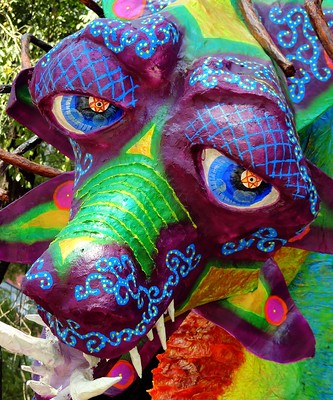
Where can I buy alebrijes?
You can buy alebrijes in Mexico. There are many souvenirs shops, craft markets, and art galleries where you can find all sizes, animal combinations, and quality alebrijes. You can also try online shops but there’s a chance the products are not Mexican.
And as we just said, you can create yours!
Share your experiences with us:
| Follow PackAndGo.info at: | |
| YouTube | @packandgo. |
| @packandgo.info | |
| @packandgoinfo | |
| @packandgo.info | |
| TikTok | @packandgo.info |
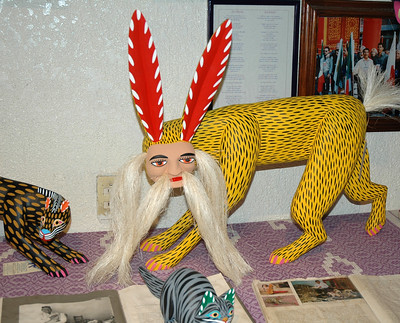
- Details
- Written by: Gianna Esquivel
- Hits: 742
I have seen alebrijes around since I was a kid. My grandma used to have a big and colorful collection. When I was afraid of the darkness and I couldn’t sleep well, she brought home a couple of alebrijes to give me courage and strength. A tiger with eagle wings, so worse case I could fly away from the danger. And a fish with claws and an owl head, to be smart to deal with my nightmares or bad ghosts, and agile to swim away from them.
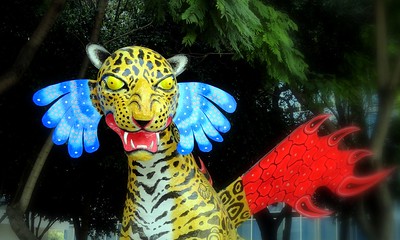
Those alebrijes were on my nightstand long time. For me, they represented my grandma in the shape of those exotic figures protecting me while sleeping and giving me the necessary strength to stand by myself. Those lovely alebrijes moved away only when my grandma died. I was very sad. She and her alebrijes gave me a lot of good stuff for years. Since we couldn’t be together anymore, alebrijes could take care of her and be nice company.

Alebrijes are a beautiful Mexican tradition and they have become internationally popular. If you are ready to Pack and Go to Mexico, this article can prepare your magical encounter with those fantastic and colorful Mexican creatures.
| Follow PackAndGo.info at: | |
| YouTube | @packandgo. |
| @packandgo.info | |
| @packandgoinfo | |
| @packandgo.info | |
| TikTok | @packandgo.info |
What the Mexican alebrijes are?
Alebrijes are Mexican crafts that recreate figures of hybrid animals. That is, each figure combines physiognomic elements of different animals. The craftsmen are mainly based on real animal features, but their combination results in a fantastic, non-realistic animal figure. In practical terms, they are used mostly to decorate people’s homes.
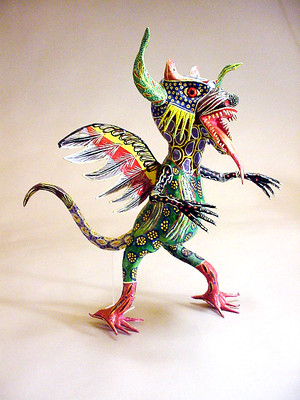
There are different animal feature combinations, sizes, from a little version not bigger than your hand to monumental versions up to 3 or more meters high. These last can be seen in exhibitions and parades.
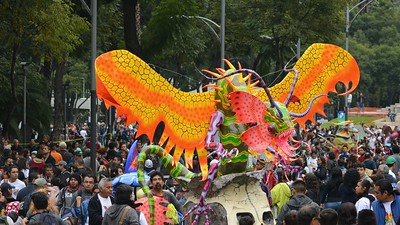
What is the story behind alebrijes?
The story behind alebrijes is not too old and it’s an interesting one. This level of fantasy and creativity was the result of a human illness.

Alebrijes were created by the Mexican handicraftsman Pedro Linares López in 1936. Pedro Linares was born in 1906 in Mexico City. He was “cartonero”, meaning a man dedicated to papier-mâché sculpting of piñatas, masks, Catholic saints, and more Mexican figures. This is a traditional and popular handcraft in Mexico and it’s called “Cartonería” in Spanish. The kind of texture the paper gets after the sculpting process refers to the paperboard’s one. It’s also called “cartón-piedra” (paperboard-rock) due to its final rigidness.

When Pedro Linares was thirty years old (1936), he got a severe illness that produced high fiber for a long time. While being unconscious, he had a dream or a hallucination, in which he was strolling around a weird forest. There, he found different strange and colorful creatures like a winged donkey, a rooster with bull horns, and a dog-headed lion. They all were yelling the same word, “alebrijes”.
Against the initial medical prognosis, he managed to heal. He got back to his artisan workshop and then he decided to replicate the fantastic creatures of that dream. The result was several exotic chimeras visually very attractive. Pedro Linares's creation was a success and soon, more handicraftsmen imitated his alebrijes using the same technique, “Cartonería” or papier-mâché sculpting.

Even the famous painters Frida Kahlo and Diego Rivera requested Pedro Linares to create alebrijes for them. This collection is currently available in the Anahuacalli Museum in Mexico City. In 1975, Judith Bronowski, a British filmmaker produced a documentary about alebrijes and his creator. Pedro Linares never imagined that a hallucination could solve his economic problems and change his life in such a way. His alebrijes became a great contribution to Mexican popular art.
What is the origin of Oaxaca alebrijes?
The original alebrijes were created in 1936 by the Mexican handicraftsman, Pedro Linares López, in Mexico City. As we already explained, his alebrijes got really popular all around Mexico and even abroad. Handcrafting is a common activity all around Mexico. Techniques, materials, and styles vary based on the town, region, or state of the Republic. When the alebrijes succeeded, handicraftsmen from Oaxaca and other Mexican states saw the opportunity and replicated Pedro Linares's alebrijes. With time, they developed their versions. In Oaxaca, handicraftsmen started sculpting alebrijes using their traditional copal wood, instead of paper and the papier-mâché technique.

People liked the result and more handicraftsmen in Oaxaca turned to alebrijes as the main product or included them in their variety of figures. After, they added a mystic factor to their alebrije version. They said they got the inspiration to create them on the nahuales, a pre-Hispanic myth that involves animals as protectors or guardians of humans.
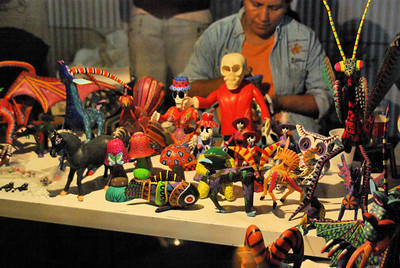
What is a nahual?
Nahual is a supernatural entity that is documented in different stories from the pre-Hispanic times. It had been pointed like a witch, evil, or a guardian. In Oaxaca, a nahual is a guardian every human has. And this guardian is an animal.

Old people from Salina Cruz, La Ventosa, San Vicente de las Piñas or Huajuapan de León in Oaxaca have explained that a nahual is the animal with which you have a supernatural relation since you get born. It is like your twin in an animal version. It becomes your protector forever. And with time, you should develop the skills of such animal, and even a sort of therianthropy, meaning to be able to transform in that animal. The animal could also transform into a human.

Others in Oaxaca tell a darker story. A nahual can also be an entity that tortures souls during their trip to their altar. It is especially evil with the youngest souls. Some rituals are required for humans to help those souls to reach their destination safely.
What is the myth of the nahual in Oaxaca?
In Oaxaca, the myth of the nahual says that every newborn should get his or her nahual. To get it, once the mother gave birth, her baby should be taken to a forest or a field to be left in a quiet spot there with the close surveillance of the parents.

Then, they had to wait for the first animal to get close to the baby. This animal would be the baby’s nahual. His or her guardian for life. And with time, due to this supernatural bond, the human could develop the animal’s skills and the ability to transform on it and vice-versa.

The dark version of the myth says a nahual is an entity from the supernatural world that tortures souls during their journey to their altar. It is said that the nahuales come from humans who were not good in life. So, when they die they are transformed into permanently hungry and thirsty beasts.

Nahuales are said to be crueler to young souls. For this reason, people usually include a guard dog, or itzcuintli, on their altars to protect them and ensure their safe arrival at their destination.
Conclusion
Alebrijes are fantastic and colorful Mexican creatures. Now you know the story behind their creation. If you are going to Mexico, don’t miss the chance to get some! They can get your heart just like my grandma's alebrijes did with me or if you like to believe in supernatural guardians, well, you’ll have an extra hand, just in case. They are a beautiful tradition that it’s worth meeting and sharing with your loved ones!
Share your experiences and favorite alebrijes with us.
| Follow PackAndGo.info at: | |
| YouTube | @packandgo. |
| @packandgo.info | |
| @packandgoinfo | |
| @packandgo.info | |
| TikTok | @packandgo.info |
- Details
- Written by: Gianna Esquivel
- Hits: 1676
When December arrives, most of the people in the world focus on the Christmas celebrations. Meanwhile, in Mexico, millions of people are getting ready for a different and big celebration.
December 12th is the Day of the Virgin of Guadalupe also known as Our Lady of Guadalupe. It’s a massive celebration for Mexican Catholics. Not every Mexican celebrates it, but based on the latest official census 2020, 77.7% of the population is catholic.
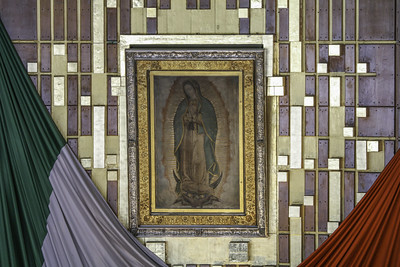
On December 12th, Mexican Catholics show their gratitude and faith to one of their biggest religious icons. It’s a day for them to visit the virgin in the Basilica of Guadalupe to ask favors and miracles too. It’s a celebration but being religious, it’s not a party but a mixture of festivity, faith, offerings, sacrifice, devotion, and church rituals. Happiness, pain, tears, and sweat are part of the environment.
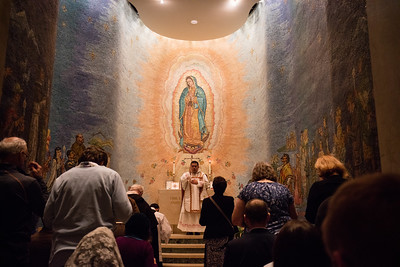
From December 1st or even a month before, depending on how far they live from the capital, pilgrims from all over the country get ready to travel to Mexico City for the celebration. But it’s not a common pack and go, some go by bus or car, but most of the so-called pilgrims follow the tradition of going from their hometowns and cities to the capital by bicycle or by foot. Yes, some of them walk more than one thousand kilometers carrying images, figures (all sizes, small, big, and even human-size), paintings of the Virgin of Guadalupe. Their goal is to arrive in the Basilica of Guadalupe to kneel in front of the image of the virgin to receive her blessing.
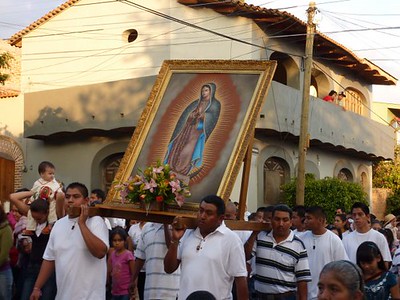
To give you a reference, in 2019, based on Mexico City government statistics, 9.8 million pilgrims visited the Basilica of Guadalupe, located in the Mexican capital.
Let’s dive into more details for you to know what is exactly December 12th for Mexicans. If you get interested, you could include the celebration on your next traveling plan.
YouTube @packandgo.info
Facebook @packandgo.info
Twitter @packandgoinfo
Instagram@packandgo.info
TikTok @packandgo.info
What is celebrated on December 12th in Mexico?
Officially, on December 12th, Mexicans commemorate the myth of the appearances (four in total) of the Virgin of Guadalupe that occurred in 1531 to Juan Diego, a humble peasant. The myth says that the virgin appeared to ask for the construction of a temple in her honor. The exact place pointed by her is where the current Basilica of Guadalupe is located.

But in the 20th century, with the beginning of the TV in Mexico, the celebration included a musical to sing the traditional “Mañanitas” to honor the virgin. The “Mañanitas” is the Mexican song used to celebrate people’s birthdays. For this reason, some people think that December 12th is the birthday of the Virgin of Guadalupe. This version is common but not correct, not official. To be clearer, it’s not about the virgin’s age, but the moment she appeared for the first time/times.
Besides, this day, Mexico celebrates the name day of all women and men that are named Guadalupe. Some people also call the date “Lupitas’ Day”. Lupita is a common nickname for Guadalupe.
The celebration of the name day is also a religious tradition. Christians, mostly in the Americas and Europe, yearly celebrate the day of the calendar linked with their baptismal name. Most of the existent names have a biblical or saint origin.
Do you know what Mexicans celebrate on the 5th of May? Read about it here: "Cinco de Mayo is not what you expect."
What is a myth?
Myth is defined as a symbolic narrative, usually related to early events in human history, used to explain natural or social phenomena. Commonly, a myth involves supernatural events or beings and for this reason, such a story is pointed out as not objectively true or possible. Many myths are connected with different religious beliefs worldwide. Religious beliefs, as you know, can be delicate matters to analyze or criticize. So the more connected with a current or fundamental matter or tradition for a specific society these stories are, the harder for some people to accept them as myths.
What is the myth of the Virgin of Guadalupe?
The myth of the Virgin of Guadalupe is the story that tells how the Virgin appeared for the first time in Mexico. It narrates how her four appearances to the peasant Juan Diego happened, the obstacles the peasant had for the bishop to believe him, and to make the virgin’s will possible, building a shrine for her in the Tepeyac hill.

What’s the myth of the Virgin of Guadalupe about?
According to this myth, on December 9th, 1531, the Virgin of Guadalupe appeared to a peasant, an Aztec converted to Christianity, as a result of the Spanish conquest. This was the first of four appearances.
Juan Diego, his wife, and uncle didn’t live close to any church. To attend mass they had to go to Santa Cruz de Tlatelolco. One day, while passing through the Tepeyac hill, Juan Diego heard a song. While enjoying it, he saw a lady praying, covered by a shiny light. He got closer and the lady talked to him in Nahuátl. She said she wanted a shrine to be built exactly there, on the Tepeyac hill. And she asked him to communicate this to the bishop.
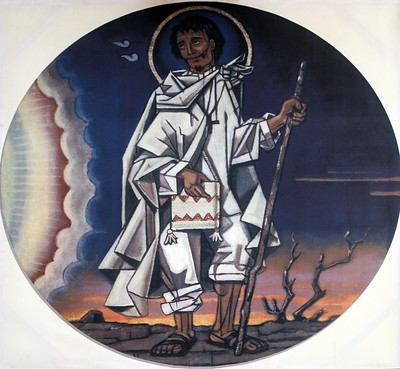
Juan Diego was not taken seriously by the bishop, who asked him to return to the hill for confirming if what he saw was real. Sad due to his unsuccessful meeting, he got back to the hill and the virgin appeared to him for the second time. She asked him the same. To deliver her message to the bishop. Juan Diego met the bishop but he asked for proof, evidence to support his words. The peasant communicated this to the virgin, during a third appearance. And she asked him to get back the next day.
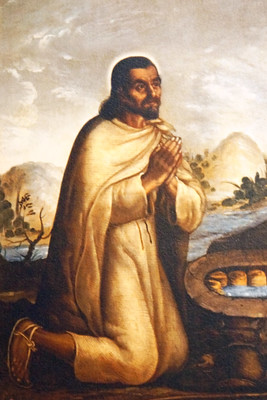
This time, Juan Diego didn’t get back. His uncle got very sick so he stayed home to take care of him. The uncle didn’t get better so, on December 12th, Juan Diego looked for a priest to perform the last rites to his uncle. Passing through the Tepeyac hill, the virgin appeared to him. Then she knew about his uncle’s illness. She told him not to worry, ensuring he was already healthy because she healed him. She asked him to pick some roses from the top of the hill. He obeyed, and when he reached the top he found a beautiful type of roses not common there, and in a season when usually there were no flowers. He picked the roses in his ayate (outer garment worn by men in the countryside, similar to a blanket used as a cape, knotted over one shoulder. It was made of maguey fibers, henequen, or cotton). The virgin asked him to take them to the bishop. She ordered him not to unfold the ayate to anyone else.
Once in front of the bishop, Juan Diego unfolded his ayate and besides the roses, the image of the Virgin of Guadalupe appeared in the fabric. This was the proof to the bishop of the virgin’s appearances and will.
This myth is close to five hundred years. The temple was built in the current location of the Basilica of Guadalupe, in Mexico City.
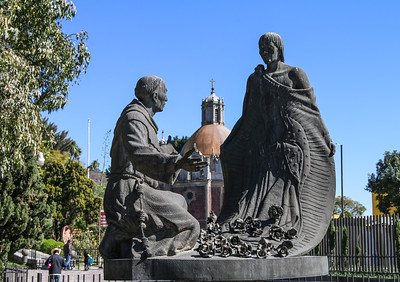
How is the Day of the Virgin of Guadalupe celebrated in Mexico?
The biggest and most popular celebration occurs in the Basilica of Guadalupe located in Mexico City. But Catholic churches all across the country also celebrate. There are special masses dedicated to honor and to thank the virgin. Churches are more decorated than usual. The aromas of the vast amount of flowers they buy and the incense are intense. Church choirs include in their repertoire songs about the virgin or specially dedicated to her. Outside the churches, you can see fireworks, firecrackers, food stands, all kinds of products on sale with the image of the virgin (clothes, candles, figures, stickers, postcards, rosaries, etc.).
Some people dedicate their dances as an offering. You can see dancers of pre-Hispanic music, ranchero, and more traditional music.
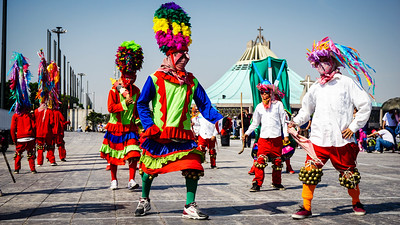
Musicians directly or believers in general also organize serenatas for the Virgin of Guadalupe. Mariachi, banda, norteño, to trios, duets, or soloists play and sing for her making the environment happier with their music.
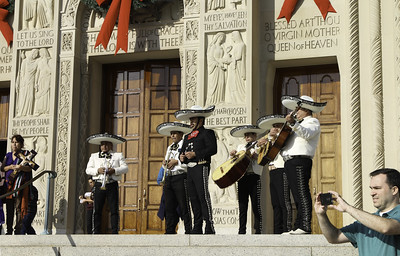
Some mothers dress their kids in traditional peasant clothes, referring to the myth of Juan Diego.
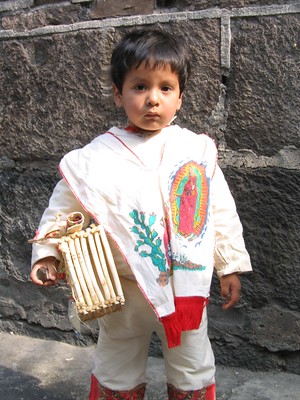
The belief is the virgin protects people, helps with difficult causes humans can not handle. She can even intercede with God, for him to help them when situations are too hard and they seem only fixable through a miracle. Based on how big the problem is, people offer something in exchange for this help.

So many believers choose December 12th to pay for such help or favors like to recover the health, the life of a son that is fine after an illness or a difficult labor process, to obtain a job, etc. The way of paying involves offerings or sacrifices. They pray, make donations to a specific church, afford the renovation of the virgin’s altar, buy big amounts of flowers to decorate the church, they also comply with promises like to move long distances not by walking but on their knees. Many get severe pain and injures due to this practice.

Millions of Mexicans choose to pay pilgrimage for honoring the Virgin of Guadalupe. They move from their cities or towns to the Basilica of Guadalupe in Mexico City. Walkers carry images of the virgin. Bicycles and other vehicles get decorated with flowers and religious images. The main highways connecting the capital with the rest of Mexican states get crowded with pilgrims. Men, women of all ages, children included, pray, sing, or remain in a silent vote during this long journey to the capital.

In Mexico City, some believers celebrate by helping pilgrims in their arrival to the capital. They prepare food, water, or warm clothes to give away to the pilgrims. They move to the main highways or entrances to the capital and remain there basically from December 11th to December 12th to welcome and help the pilgrims. Police and ambulances also follow pilgrims to support them when needed. Dehydration, injuries to feet, knees, legs, cramps, muscle aches, hypothermia are common.
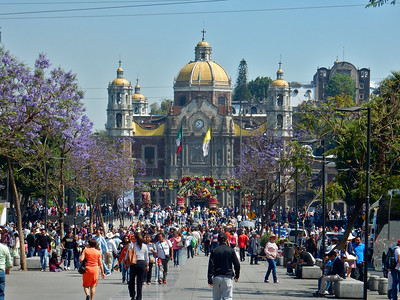
The esplanade and surrounding streets of the Basilica of Guadalupe get crowded. Some pilgrims sleep there on public benches or tents when they arrive.
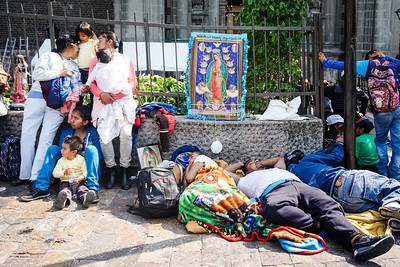
And exactly the first minute of December 12th, a serenata takes place in the Basilica. Popular Mexican singers offer their songs to the virgin, including the traditional “Mañanitas”. That is the first song that is performed.
Another big celebration in Mexico is the Mexican Mother's day. Do you want to know how they celebrate it? Read this article: "The controversial Mexican Mother’s Day".
Conclusion.
December 12th is an important date for many Mexican Catholics. The biggest religious celebration takes place on that date in the complete country. If you want to be part of this celebration, it’s better to know what exactly it is about to behave properly. After that, you only need to pack and go to Mexico in December not to miss it.
If you enjoy reading about Mexican culture, check out this article too: "Everything you need to know about the Mexican mariachi!".
Share your experiences with us:
YouTube @packandgo.info
Facebook @packandgo.info
Twitter @packandgoinfo
Instagram@packandgo.info
TikTok @packandgo.info
- Details
- Written by: Gianna Esquivel
- Hits: 2194
Mother’s Day is one of the most popular celebrations in Mexico. Every year there’s a strong Marketing investment from all types of companies that want to capitalize on the day of “la reina de la casa” (the home’s queen). But besides this, it’s a very ingrained festivity among Mexicans. The mother’s figure has a strong influence not only on kids but also on adults.

In Mexico, Women’s Day is not as big as Mother’s Day. And Father’s Day has been promoted just recently. But there’s no way to compare the dimension of both celebrations. Mother’s Day can stop the regular activities in most of the offices in the country.
Schools organize festivals every year to honor our mothers. Kids sing, dance, and create handmade gifts for their moms. And then, the celebration becomes a habit (some will prefer to call it a tradition) we reproduce forever. Yes, no matter the mother already passed away, we will keep celebrating her somehow. Usually, the celebration reaches cemeteries every year.

PackandGo.info @packandgoinfo @packandgo.info @packandgo.info
When is Mother’s Day in Mexico?
Mother’s Day in Mexico is every May, the 10th. The date is the same every year. The celebration goes on no matter it’s a working day or a rest day.

What is Mexican Mother's Day called?
Mexican Mother’s Day is called, in Spanish language, Día de las Madres. That is the official name of the holiday. However you also can hear Día de las Mamás.
What do Mexicans call Mom?
Mexicans have different ways to call mom.
- Mamá, it’s the standard Spanish word to mean mom.
- Madre is also a proper Spanish word to mean mother.
- Mami and mamita, diminutives of mamá (mommy or mom).
Now let’s go to informal, slang ways to call mom. Consider that the following nicknames are mostly used within informal contexts and they are not rude, but some moms may not like them. Sons and daughters use them to joke a bit with them.
- Má, an informal, short version of mamá. Commonly used when talking directly to her. “Má, where are you?”.
- Amá, another slang, short version of mamá. It was more common in the countryside but already is possible to hear it also in cities.
- Jefa or patrona, the boss in English. These are common and fun ways to call mother, meaning she is the one in charge, the boss of the family.
- La ley, the law in English. It underlines the importance of the mother in the family. She’s who rules, decides, who gives or denies permissions.
- La mera, mera, the big boss. It has a connotation of “bossy” that mothers may not like. But when the relationship is good, they understand their kids are just joking.
This can make you think women are powerful and very respected in Mexican society. But appearances are deceiving. Honestly, such respect or power is only delivered that way to mothers. And house and children care are the only kingdoms where women are allowed and even pushed to rule. The situation is different in the public and work contexts. Obviously, women participate and have more visibility every day. But motherhood is still a hard topic.

Statistics of domestic violence also contradict this supposed female power in the family.
Besides, this lack of balance originates toxic dictatorships in some families. Some popular telenovela scenes where judgmental mothers approve and disapprove their son’s and daughter’s adult decisions are unfortunately inspired by real cases.
Why is there Mother’s Day in Mexico?
There’s an official Mother’s Day in Mexico as a result of an initiative (1922) of Rafael Alducín, a journalist and founder of the Excelsior newspaper. Mother's Day already existed in different countries. His proposal was to choose a specific date to honor Mexican mothers. “Excélsior intends that May 10th be consecrated by the children to exalt, in life or in memory, those who gave them being (existence)”.
Later, President Álvaro Obregón and José Vasconcelos, Secretary of Education, backed the proposal together with the Catholic Church and the Red Cross.
The context here is key for you to have a clearer comprehension. The Mexican Revolution (1910-1920) was a conflict that radically transformed the economy, politics, and society. Women actively participated in the war not only taking care of children and wounded men but also on the battlefield. Some even fought disguised as men. Official narrators barely gave them credit for this, constraining their role to protect the children.
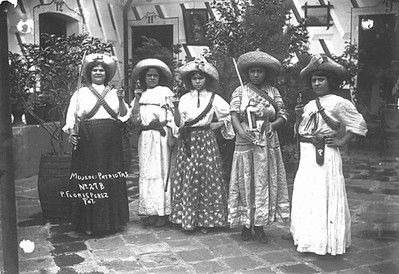
The first feminist voices began to be heard and grouped around 1915-1919. They were demanding social recognition, better conditions, sexual education, and birth control. Especially the last two demands weren’t taken well by conservatives in the country. For them, the highest women’s functions were giving birth and educating the children. Excelsior newspaper was an open supporter of this conservative way of thinking. Just like the Catholic Church.
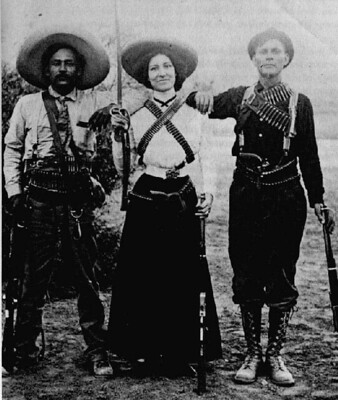
What’s Mother’s Day for Mexicans?
In simple terms, Mother’s Day is a celebration to honor women who are mothers or mother figures. The topic gets more complex because motherhood, maternal bonds, mother’s influence in society, family values, and even traces of the Catholic heritage also get involved.
If you ask Mexicans, pretty sure they will generally say the celebration is fair, good, and nice. But talking more particularly, it’s controversial because not every mother likes it and not all sons and daughters want to celebrate it. Basically, the issue is its origin, and the different meanings we attribute to the festivity or to the “mother” concept.
Here you have some opinions of Mother’s Day. All expressed by Mexicans (women and men).
“It’s insulting to celebrate women solely for giving birth. Still in the 21st century, there’s a try to point this is the only thing women are really good for”. Teresa, 31 years old.
“May 10th historically celebrates the selfless and sacrificed mother. The most convenient type of mother-woman for the macho society”. Laura, 56 years old.
“Mother’s Day is a hypocrite day. We put our mothers and wives on a throne for a day, and ask them to wash our dirty pants the next one”. Rodrigo, 41 years old.
“Many Mexican families live a cruel mother's dictatorship. If this is the only area where women are allowed to be, some can get really suffocated and suffocating rulers”. Gloria, 46 years old.
“These exaggerated mother’s worship means a lot of social pressure for women who don’t belong to the traditional profile of a sacrificed mother, only in charge of the kids. And even for men, because no matter what they do, they will never be as good fathers as mothers are”. Lorena, 51 years old.
“My father never wanted to be in charge of our education, health, etc. He gave our mother the control of the family only to avoid his responsibility”. José, 28 years old.
“My mother truly believed she had the power to decide every aspect of my life, based on the fact she gave me birth. I don’t talk to her 20 years ago”. Evelyn, 40 years old.
“Mothers are humans. They have hits and mistakes. To make them believe everything they do is ok just because they are mothers is really unfair”. Joaquín, 30 years old.
“To think you will delete your bad actions or the pain you cause with a new iron, sweater, or some roses is ridiculous. I don’t like May 10th”. Susana, 72 years old.
“I like the celebration but I hate the gifts. A washing machine, an iron? Does mother mean slave?”. Thalía, 27 years old.

Of course, many people celebrate to show authentic love and gratitude to their mothers. But that is the side of the coin that is always shown. And you can’t expect such a consensus about a human matter in a country as big and culturally diverse as Mexico is.
Who does celebrate Mother’s Day in Mexico?
Everybody can join the festivity, but especially those who have a mother or mother figure celebrate Mother’s Day in Mexico. Biological mothers, foster mothers, or women playing that role, living and dead, are honored on this day by their sons and daughters.

How do Mexicans celebrate Mother’s Day? - Mexican Mother’s Day Traditions.
Mexicans celebrate Mother’s Day by giving presents to their mothers and gathering the whole family at a party, brunch, or dinner. Pretty much what people do everywhere in the world. Mexican traditions you can observe are mariachi serenades, school festivals where kids perform musicals, poems, songs, etc. And there are special mass services for living and dead moms. People pray for the health and long life of their moms, and for the dead ones to rest in peace. Mariachi serenades and family gatherings also take place in cemeteries, around the mother’s tomb.

What are common Mother’s Day gifts in Mexico?
The list of common Mother’s Day gifts in Mexico can go really long. Basically, everything is possible. Budget and mother’s particular preferences define the type of present. A homemade cake or card, crafts, perfumes, all sizes of flower bouquets, TV sets, furniture, chocolates, clothes, shoes, accessories, jewelry, spa sessions, travels, restaurant gatherings, serenades (mariachi, norteño, banda, etc.), and so much more.

Home appliances are widely bought for mothers, stoves, laundry machines, vacuum cleaners, blender machines, irons, and so on. But these are the kinds of gifts some mothers don’t like because of their direct connection with the housework.

Conclusion.
We Mexicans love to celebrate and we love our mothers too. Both are big features of our identity. But what I learned from my own mother was, we must keep in mind a mother is a human and a woman with ambition and personal goals that her couple, sons and daughters should respect and in the best case, support. To be a mother is just a facet of her that shouldn’t cancel or limit the others.
Besides, a mother should be appreciated daily, not only on a single day of the year, created by the media, and without knowing well its origin or purpose. It’s through our daily actions that we can honor her best.
Finally, celebrating her for the right reasons is a great idea. You can make her really happy. Just choose a nice gift for her! Remember that home appliances can ruin her mood and the celebration.
Share your opinions with us and join PackandGo.info @packandgoinfo @packandgo.info @packandgo.info

